Proposed FAQ-Countertop Material Choices
OK, here is a start on a proposed FAQ on countertop materials. I would like to be a wide-ranging as possible, so that if someone stumbles across our site, they may learn that materials other than laminate, corian, and granite are available!
Let's start by simply listing the available materials, then lets get people with knowledge and experience to fill in each section.
I'll start, and I'll make sure the list is in a 'neutral' order (i.e. alphabetical) before publishing:
Butcherblock
Ceramic tile
Concrete
Engineered stone
Glass
Granite
Granite tile
Laminate
Limestone
Marble
Richlite and similar products
Slate
Soapstone
Solid surface materials (i.e. Corian and similar)
So, what did I miss? Help me!
Comments (54)
Related Professionals
Owasso Kitchen & Bathroom Designers · Plymouth Kitchen & Bathroom Designers · Mooresville Kitchen & Bathroom Remodelers · Morgan Hill Kitchen & Bathroom Remodelers · North Arlington Kitchen & Bathroom Remodelers · Shawnee Kitchen & Bathroom Remodelers · Winchester Kitchen & Bathroom Remodelers · Jeffersontown Cabinets & Cabinetry · Mount Prospect Cabinets & Cabinetry · Palos Verdes Estates Cabinets & Cabinetry · Tenafly Cabinets & Cabinetry · White Oak Cabinets & Cabinetry · Farragut Tile and Stone Contractors · Niceville Tile and Stone Contractors · Woodland Design-Build FirmsCloud Swift
16 years agolast modified: 9 years agoQuartzite is one of the stone types that is commercially grouped as a granite (even though it isn't granite to a geologist). It isn't the only one. At the slab yard they called our Azul Do Mar granite. In the FAQ on granite it should explain that. Here is what the article on granite types at Findstone says:
Granites in the commercial sense are hard natural stones which are polishable and they must be worked on by harder tools than for marbles for cutting, shaping and polishing. They are usually suitable for internal and external use.Commercial granites have different geological origin and minerals. Petrographically, they are either magmatic or metamorphic rocks. True granites, i.e. granites in the scientific sense, are only their one group. They are light magmatic rocks formed by crystalization from magma under the earths surface.
A similar statement applies to the commercial use of "marble" for many types of softer stone.
I think a neutral alphabetical order would be bewildering to newbies when covering wide-ranging materials. Perhaps the FAQ should be arranged with an article on the more common counter materials and another on the others.
There are recycled countertop materials like Vertazzo which incorporates recycled glass in a binder material.
velodoug
16 years agolast modified: 9 years agoLinoleum - I wouldn't recommend it, but it was once a fairly common countertop material.
rhome410
16 years agolast modified: 9 years agoWould we want to distinguish large format porcelain tile from the commonly thought of, usually small with larger grout lines, ceramic tile? It's an option not everyone knows about.
cpovey
Original Author16 years agolast modified: 9 years agoYes, we will try and list most brands of materials (like ES and solid surface) when we write the section.
Would we not list bamboo under butcherblock? It already encompasses maple, lyptus, cherry, walnut, etc.
Cork is a countertop material? I know it is used for flooring, but for countertops?
Today, is linoleum really suitable countertop material? I realize it was used in the past, but today? It is much more flammable than any other material we have listed, and I would be hesitant to recommend it for this reason.
Ans yes, we can certainly mention that cermic tiles come in larger sizes, which reduces the number of grout lines.
vjrnts
16 years agolast modified: 9 years agoToday, is linoleum really suitable countertop material? I realize it was used in the past, but today?
For people who are restoring old homes, it's an option. I would say it's a very small part of the market, but they're out there.
Personally, I wanted to stay true to the age of my house, so I chose soapstone. But the counter in my tiny butler's pantry is original linoleum from 1922, and it'll get torn out over my cold, dead body.
mcmann
16 years agolast modified: 9 years agoIf you want to group butcherblock and cherry and bamboo (although it's a grass, it functions as a wood) together perhaps you'd prefer to group them under 'Wood'.
Metal could include stainless steel, nickel, pewter, copper, zinc and bronze.
Resin counters http://www.3-form.com/
kitchendetective
16 years agolast modified: 9 years agoYes, cork is used for counters. A good friend bought a tract house with cork counter tops and HATED them. She put a large burn spot on the cork with a pan the week she moved in and tells everyone not to get cork.
mayland
16 years agolast modified: 9 years agoAlso recycled paper counters -- Paperstone and Richlite
velodoug
16 years agolast modified: 9 years agoToday, is linoleum really suitable countertop material? I realize it was used in the past, but today? It is much more flammable than any other material we have listed, and I would be hesitant to recommend it for this reason.
Didn't I say I wouldn't recommend it? I'm confident that someone here could come up with a plausible argument against each and every option listed. I don't think that's a reason to omit them from the list.
FWIW, a mid 20's kitchen I worked on recently had linoleum countertops which we replaced with a satin finish laminate and the original extruded metal edges. We kept the original white painted cabinets too.
cpovey
Original Author16 years agolast modified: 9 years agoOK, here is the list (alphabetical at present) as I see it.
Are we missing anything? If so, let me know.
Colin
Ceramic tile
Concrete
Cork
Engineered stone
Glass
Granite
Granite tile
Laminate
Lavastone
Limestone
Lineloeum
Marble
Non-stainless steel metals: Zinc/Pewter/Nickel/Copper/Bronze
Quartzite
Resin
Richlite and similar paper-based materials
Slate
Soapstone
Solid surface materials (i.e. Corian and similar)
Stainless steel
Wood (maple, lyptus, bamboo, walnut, cherry, etc.)carpentershop
16 years agolast modified: 9 years agoBetter put Solid Surface Veneer and the Granite Transformation junk in there. I would think it would be as important to cover what doesn't work well as the good choices.
Swanstone is different enough from regular solid surfaces that it needs it's own catagory.
The quartzite catagory is problematic. There are many "granites" that aren't true granites but are sold as such. Not that much differnet than the quartzite. How about a spot for true granites and the want a be stones?
Need to add Quartz to the Engineered stone catagory. Some of the brands are sensitive about the moniker Engineered stone and market it as quartz.
sundial_gardener
16 years agolast modified: 9 years ago"Recycled glass" might be a section (Terrazzo, Icestone, Enviroslab).
"Recycled paper" could be another section (Paperstone etc).
Or else there could be a "recycled/environmentally friendly section" including the recycled paper and the recycled glass countertops.
Fori
16 years agolast modified: 9 years agoPerhaps add a note that while some materials may be more conducive to bacterial growth when improperly maintained, none cause cancer.
You're brave to take on this topic: the plastic vs rock people could take their battle here! /eyeroll
cpovey
Original Author16 years agolast modified: 9 years agoSolid surface verneer-I now this used to be available, but I looked fo rit and could not find it.
What is Granite Transformation? Never heard of it. Any info?
Ditto Swanstone
Re: ES and Quartz. How about I list it as Engineered Stone/Quartz?
Don;t really know what Quartzte is. Can someone help here?
Recycled glass is good
Doesn't Richlite and Similar paper-based materials cover Paperstone? Mybe I should call it Richlite, Papaerstone, and similar products?
cpovey
Original Author16 years agolast modified: 9 years agoFolks, I will be on vacation for two weeks, but I dont want we have started to fall through the cracks.
What I would like to see is different people choose different countertop materials, ones they are familiar with, and compose a small section on the advantages, disadvantages, and primary competitors for use as a countertop material.
Here is one I have written on Engineered stone. Let's follow the same format with each.
Please create similar write-ups on different materials, from the list above, and submit them here. When I return, we can debate them, polish them up, and submit them as an FAQ.
To be perfectly fair, let's have no one associated with any of the materials, like stone, glass, stainless, or laminate people, produce any of the sections.
**************************************
Material: Engineered Stone (ES)/Quartz
What it is: A man-made materials that is roughly 95% natural quartz pebbles in a colored binder, similar to an epoxy. Because quartz is generally clear, the material takes on the color of the binder. Seven major brands available for sale in North America: Cambria, Silestone, Zodiaq, Hanstone, Cæsarstone, Technistone, Avanza. Each offers different colors.
Competes mainly with: Granite, marble, other stones, solid surface.
Advantages: Non-porous, meaning no stains. Maintenance free-no sealing, oiling, etc. required. Clean with soap, detergent, 409, Windex, virtually anything. NSF certified for use in commercial kitchens, it does not harbor bacteria because there are no cracks or crevices. Most come with a 10 year warranty, if installed by a certified installer. More uniform in appearance than granite, and comes in a wide array of colors. Largely heat resistant. Long life span. Many possible edge designs.
Disadvantages. Very uniform in appearance, none of the dramatic beauty possible with granite. Expensive, often more costly than many granites. Is not as heat resistant as granite. One series is made with a fine quartz powder instead of pebbles, and achieves a look similar to marble. But this version is much softer and more likely to chip than other ESs. Very hard, like granite, so can be hard on crystal and other delicate items.
carpentershop
16 years agolast modified: 9 years agocpoovey,
Solid surface veneer is still around. Some Wilsonart fabricators will still sell it for vanities and there are new versions that pop up every year at the KBIS show, the builders or AWF or Surfaces show.Granite Transformations is a very thin quartz/engineered stone veneer that is glued down on top of existing countertops. It has expansion issues with other materials, so is likely to crack if glued down on the wrong material. They glue it to formica, wood, plywood, tile, almost anything without regard to the substrates expansion ratio and whether or not it is the same as the quartz expansion ratio.
A good example is concrete and rebar, which work well be cause they have very close co-efficent of expansion rates. Another expample of this issue is a barometer, two dissimular woods strips glued together, which bends the barometer to show the humidity level because of the different co-efficents of expansion rates of the two woods.
On having people not associated with the materials write these examples, I have questions. I see the need to keep a stone seller from writing about the stone, but he will do a poor job writing about a material he has no experience with and has prejudice against since he competes with it.
I sell and fabricate all of them and feel that having the practical knowledge and experience is crucial to having a unbiased opinion. Having a homeowner write about "their" granite will also skew the article from exposure to only one type of granite and little practical experience.
What about taking the granite write ups from granite guys, then making them defend their statements? Make them write them consistent ot the Marble Institute care and cleaning info, which will solve 90% of the mis information.
To show the issues in writing this primer on materials without practical experience, I am going to point out the problems with your quartz example. No offense, I usually agree with your advice and consider you unbiased. Problem comes up when people don't know what they don't know...
Not all engineered stone is quartz based, why I recomended a separate catagory for E-stone. Some is marble based (calcite) which must be cleaned differently and acid foods kept off it. Some doesn't use quartz, it uses ground up granite which is composed of quartz, feildspar and mica amoung other minerals. It performs radically different than pure quartz which is probally unobtainable.
The ratio of quartz to binder is around 93 to 97% by weight, which means it is closer to 65% by volume. That is important because the quartz portion will stain and the polyester portion will scratch. When it first came out, the brands chose to market as scratch proof, heat proof, and stain proof. They later ran ads in Kitchen and Bath Jounals saying it was not heat, stain and scratch proof and all major brands mention to use trivets, not cut on it, and most have exculsions on staining. Also, they call them heat, stain and scratch resistant, far cry from proof. They do not warranty heat, stains or scratches either, which is the proof of the pudding in my book for their marketing claims.
It is less porous than granite, but the quartz portion will stain to some extent, thus their warnings on some household products. I can post a link to their lititure, but it is on my website and I belive it is a no no to link to my site. I will get it posted somewhere else and link to it later.
Some brands warn to use Ph neutral cleaners, WIndex and 409 are not recomended, in fact they are warned about.
Not all quartz is NSF51 certified, only some brands. This is very important to point out.
It does indeed harbor bacteria, in the quartz voids and crevices. Quartz will shrink as much as 50% as it cools, which is why granite is so porous. Also, all materials will harbor bacteria in the polishing crevices and scratches. Even solid surface has these scratches, most is polished at 60 micron, some at 30 micron, some high polished tops go to 15 micron before buffing with compounds begins. Bacteria can be as small as .05 micron, from 30 to 120 times smaller than the peaks and valleys left by the polishing process.
Plus, you have the seams and undermount sinks, as well as the set on splashes on the quartz, all places for bacteria to hide and thrive.
It is not heat resistant, anything over 175 degees will damage the solid surface portion of the product, as well as causing quartz "pops" when the quartz grains heat up, expand and pop out of the matrix. You must use a trivet for electic skillets, crock pots, and hot cookware to keep the product looking good.
It would be better if all products were described as not being heat, stain and scratch resistant, but some are more stain, heat and scratch resistant than others. Perhaps a rating from one to ten would work. Scratch that for granite because of the differnet materials available, quartz as well performs differently.
The edge designs are the same as granite, not a large variety at all when you compare it to wood or solid surface.
Add pooling issues and yellowing of the polyester resins over time to the disadvantages.
I am a stickler for accuracy and can provide links proving all of this from stone sites, quartz brands sites and countertop material sites to back it all up.
Cloud Swift
16 years agolast modified: 9 years agoI'll take a start on granite - though I think one could summarize:
Advantages - it is a natural material - each slab is unique.
Disadvantages - it is a natural material - each slab is unique.
:^)
Not committing to continue editing this so if someone wants to take it over that's fine with me.
I didn't include the "competes with" entry. It quickly becomes a list of all the other materials in the FAQ. I guess one could have an "is most similar to" category but I think even for that it is hard to arrive at a useful cut line.I guess one could divide the countertop materials into:
hard surfaces continuous over large (e.g. at least 2 foot by 5 foot) area: i.e. slab stone and other stone like hard surface materials) and maybe the metals.
hard surfaces interspersed with grout: ceramic tile, stone tile, etc.
softer surfaces: laminate wood.Material: Granite slabs
What it is: Commercially, "granite" is used to refer to a variety of metamorphic and igneous rocks. This icludes stones such as quartzites and syenites in addition to true granites (i.e. as geologists define granite). All are relatively hard (as compared to soapstone and commercial marbles). Most resist etching by kitchen acids (e.g. lemon juice, vinegar, wine). Some (e.g. syenites) are subject to etching. Slabs are generally 4 to 6 feet by 7 to 10 feet. Larger areas will need a seam.
Some are porous and need sealing (about once a year after the initial sealing) to resist staining. Some are non-porous, meaning no stains. Ammonia-based and bleach cleaners can break down the sealer so avoid using on sealed stone.
Because it is a natural material and because of the number of similar materials grouped together as commercial granite, the characteristics of granite vary. It is wise to test a sample of the stone you like for stain resistance and etching before buying. If the sample turns dark when wet, it is probably porous so you might seal before testing.
Advantages: Smooth work surface. Some have dramatic patterns. Largely heat resistant but thermal shock may cause a crack. Long life span. Many possible edge designs. Common varieties may cost less than other solid surface materials. Some varieties are very low maintenance.
Disadvantages. Some colors are not available or rare. Exotic varieties and unusual colors may be quite expensive. Hard surface can dull knives used directly on it and increase risk of breakage of a fragile item dropped on it. Variablility - every stone is different so testing samples before buying is wise. Some varieties require occasional sealing. Generally not DIY because of its hardness.
-----------------
Tried to stay pretty high level. There are a whole bunch of FAQ for granite not answered by this so a granite FAQ article would be useful:
2 cm vs. 3 cm.
Different ways to buy - buying whole slabs, buying by sq foot from a seller/fabricator.
Support for overhangs.
Choosing a fabricator.
Should you approve the template layout on slabs.lacuisine
16 years agolast modified: 9 years agowhat about onyx?
And Syndecrete - www.syndecrete.com
similar to concrete, but not as heavy and not as easily stained.LC
paulines
16 years agolast modified: 9 years agoStonegirl wrote a wonderful piece on sealing stone ~ very informative. Would anyone have any objections if we were to include it in the granite section?
Here it is (a bit of editing may be necessary, lol)
sundial_gardener
16 years agolast modified: 9 years agoI noticed that Avonite came out with a "recycled products" collection.
Maybe there can be a "recycled products/green/environmentally friendly/sustainable design" section with all the search engine words so that people will find it easily.
pharaoh
16 years agolast modified: 9 years agoSerpentine (can be clubbed under marble)
It is a great material for counters. I have it had for a year and love it...
sweeby
16 years agolast modified: 9 years agoWith all due respect Fori, should I write about the Absolute Black granite in our boys' bathroom? The Baltic Brown in Hubby's office and the laundry room? Or the Juparana Dunas in the kitchen? All very different...
Fori
16 years agolast modified: 9 years agoNo, Sweeby, but you're probably in an excellent position to provide a general overview of granite which would be good enough for the FAQ. If you don't know where the pros and cons are, who would?
I don't think the FAQ was planning on dealing with every stone, was it? I think it's just to give new kitcheners a feel for what's out there; not to replace their own research.
carpentershop
16 years agolast modified: 9 years agoFori,
The point that sweeby was making is a valid one. Not all granite slabs are like "yours".A pro can give better info, especially if they sell all types of materials.
The fabricator network is working on a new chart. I would do things a bit different on some of the items, but it is the best one I have seen.
When it is finished, after all the stone, quartz, solid surface and laminate guys have had their say on it, I will post a link to it here.
gillypie
16 years agolast modified: 9 years agoCheck out stonegirl's thread on granite. I think it should be on the kitchen faq.
sue_ct
16 years agolast modified: 9 years agoOK, I can't resist. I have only been on this forum a few a weeks a I really appreciate countershop lending your knowledge, but seriously, NO ONE, including myself, seems to consider you unbiased. I wondered if you were actually able to keep a straight face while you were typing that. I hope you keep posting your OPINIONS, but if you got to write this section, it would render the section useless to people actually seeking unbiased information. You see, I am a nurse but I worked full time for 15 yrs for law firms on corporate medical defense cases. I hired experts, reviewed studies, had experts from Yale, Harvard, and the Mayo Clinic explain about real scientific studies from junk science funded by biased sources. I learned a lot from the researchers at the top universities doing real, unbiased medical research out of the lime light. I prepared cases for trial by evaluating the strength of our arguments, but more importantly, the strength of the oppositions. I know a hired gun when I see one/hear. I felt I held the enviable and rare position in a law firm of not having to be biased because I was more valuable by being able to see both sides and advise the trial attorneys about whether we had the strength to win or when we it would be smarter to pay what we had to in order to make the case go away. I also know biased studies being developed by the very people who stand to loose or gain the most money from outcome are all too common an nothing new, but they don't become legitimate science just because they are still being done 25 years later. Dreaming up studies that will hurt the competition and then "taking bids" on who the financiers will allow to conduct the study to give it legitimacy may make for good ad copy, and maybe that is all you want, but I would be a pretty penny that you want more. Publish biased studies and use them as ad copy and there will undoubtedly be law suits. Here on this forum you get to see how your arguments stand up against the "stone experts" that will used to discredit your studies and polish those arguments before your claims are countered either in the court of public opinion or in the law courts.
sue_ct
16 years agolast modified: 9 years agoROTFLMAO!
I pressed submit instead of preview by accident, and now I can't take it back!
That will teach me!
I usually edit most of it out after I vent, but that is not an option this time!
Carpentershop, I was going to at least say that I respect a good debater as someone who loves to argue a point just for the sake of arguing, as well as to pit their intelligence against that of others for fun of it, and those who do just because they love the love challenge or just like winning. But every good debater has to take a side, and can't be unbiased.Sue
Fori
16 years agolast modified: 9 years agoIt's OK Sue. When you're right you're right.
Really, I think a paragraph about stone is adequate for an FAQ. Like Countershop (funny typo--sorry CS!) says, all stones are different. That's the first sentence in the paragraph. Second second deals with overall looks, 3rd with general fabrication methods, 4th sentence says here are some good ways to test a stone and sealer for durability, and 5th says do your own research cuz they're all different. There. Was that so hard?
And I won't be writing about "my" granite. I don't have granite. I don't LIKE it.
gneegirl
16 years agolast modified: 9 years agoSeems like everyone has hit on Carpentershop's unbiased opions here - including myself. I'm really beginning to think it's fruitless because he isn't going to change. That said, there are enough professionals on this forum for everyone to reach some conclusions (except which color to decide on!!), just based on the information they disseminate. It's better than what we get outside of the forum. The information Carpentershop presents is an alternative to consider and research - if he didn't post it, we probably wouldn't have the debate stirring that ends up as more information from everyone else. I dont' think anyone appreciates the way he presents his information, but it is food for thought. So, as I preface here, I'd also like to chime in on some type of "database" for user comments from homeowners that have actually experienced a particular granite or other countertop material. We do it anyway, in our individual posts. But if say on the FKB, a section was added for such comments - just for those overwhelming experiences. For instance, if someone has a large family or is a serious chef, they may be able to share any pros / cons based on the volume of use. A particular material may not be a problem for someone that doesn't use it that much. We could weigh our decisions based on the tried and true.
The FAQ site is phenomenal!! Huge kudos to those that coordinated to pull it all together. But I'm not convinced that our usage comments would qualify there. Hence my thoughts that the FKB or some other forum might be worth a try. I know that the FKB is mostly pictures, but maybe more captions could be used, or something similar. I'm not savvy enough to figure that part, but if anyone has suggestions - poor them on.
There are some very serious kitcheners here that are forking out a lot to have the best. I think they and the little guys, like myself could learn a lot from both the lay person and the professionals, all in one place.
Just my thoughts. Again, thank you to all the pros here!!
sue_ct
16 years agolast modified: 9 years agoI honestly didn't intend to post that full diatribe and was not intending to insult carpentershop. As I said, I hope he keeps posting his opinions. I did not state or mean to insinuate that he was not knowledgeable, just not unbiased. I do hope he keeps posting and have appreciated his reply to a post of mine, also.
Sue
gneegirl
16 years agolast modified: 9 years agoNo bad feelings here. I actually agree with you. Carpenershop has a true value add here, along with the other pros that post here. My comment was only that I've recently seen so many people "go after" the way that he expresses his comments, and not necessarily what he is saying. I hope he understands that most of us mean well. We just want the info - and he does have the gift to research it and bring it to us. Some have been mean spirited, even on this thread. That's the part I don't like.
A tribute to carpentershop - a frequent FAQ - "what does carpenterhop have to say about ...???
Sorry for any misunderstanding
carpentershop
16 years agolast modified: 9 years agoSue,
You are preaching to the choir.For years, since 1999 or so, the stone industry has relied upon exactly the kind of study that you refer to. At the bottom of this page is a link to a short article about the deficencies of this study. The followed up again in 2006, revisited the same study with only granite and quartz. Note the amount of cleaning solution used, the equivelant of 140 gallons to clean a typical kitchen. Are any of us willing to go to that extent to sanitize a countertop?
Both studies have been used and relied upon, yet the "studies" were never published for peer review. If a lay person such as I can poke holes in the thing, imagine what someone with your experience can find.
I have posted and relied on three main studies to debate the issues of granite, the Brazillian/Portugese study, the NASA funded study, and the study done by the junkscience.com site, using a health physicist as one of the co authors. The thrust of the peice was toward anti nuclear energy groups, allowed exposures and expected exposures, and the amount of radiation in granite in our nations capitol buildings. Not taking sides, just using the data to show that granite does indeed have natural radiation and some types are far, far greater in radiation levels. The Cyprus study also backed up their figures, and that was published for peer review, and I believe it was UN funded, could be mistaken.
None of the four studies named were done or paid for by the solid surface industry, unlike the two studies relied upon by competitors. The first snyder study, 1999, was paid for by Porter Novelli, a PR firm for a stainless steel lobby group, the second by the Marble Institute of America, the main stone lobby group and association.
If you pay for the study, you also set the protocol, and of course both studies supported who paid the bills.
To show the difference, we recieved an offfer by the author of the two studies in dispute to do a study for us. I have reservations about using the company, that you will see if you go to the link. A few others think it will be a good thing. I am pushing for a lab in either CA or Chicago to do the testing, experience coupled with their willingness to tell us where we are wrong leads me to beleive they will do a more unimpeachable job.
Go over to thefabricatornetwork.com and browse. Notice that they cover stone, solid surface, laminate and quartz and the bulk of the members, including me, fabricate all products. Look at the advertisements as proof.
Are some like me, convinced that granite has enough issues that it makes a poor countertop for some consumers? Of course, if you have experience with materials, and have sold enough jobs with it, you will form opinions, based on empirical information.
My complaint with the stone only crowd is that they are ignorant of the other materials. I had to compete with stone for years, then had to learn to deal with it while we subcontracted out the fabrication, then after enough problems with the local shops, we were forced into the business. It is profitable, highly profitable, and I am not complaining. Still, the more I work with it, the more I respect some aspects, while learning that the problem issues are bigger than I knew.
In the end, a warranty that covers the material is impossible, there are major health issues unresolved, there are major issues with the suitability of the material, you can not fix it in the customers home, and the feild is dominated by shoddy workmanship, as browsing garden web will attest to. Or go to any stonesite, findstone.com or stoneadvice.com and look for customer complaints or pleas for help.
And yes, I love that the stone guys tried to butt heads. It did make my arguements stand up against a harsh bunch of critics, in full public view. Were that all I was looking for, I would have went directly to the stone sites.
As was said above, most of the complaint seems to be how I say things, not what I say. I plead guilty. Customers prefer to deal with my lovely wife over me, and we make a good team. I am unflinchng about saying no when someone wants to do something stupid, not style, but something that will compromise the integrity of the cabinets or tops, or a safety issue. I have no problem losing a job over this, let my competitor suffer the consequences.
Step away from the personalities, look only at the quality of the arguements and you will come closer to the truth of the debate. The stone crowd wanted the debate stopped or moved to a stone site, that alone says it all.
Look at who posted links to studies. The granite folks posted only one that I can remember, at another site, and it was about grinding glass. Once posted, ten minutes reading revealed that it although it actually mentioned quartz, it specifically stated that it didn't support their argument. That is what caused the entire group to abandon the debate. Awful quiet over at hgtv the last few days.
And lastly, consider that they pulled not only the black list of granite, but some of the threads that supported my position, like the 400 unit condo that had almost every sink rail breaking, both rodded and unrodded. The info was fine till consumers learned of it.......
For the record, that comparison chart that Fabnet was working on? It was posted on a stone site, and met a very rude reception, even though it was clearly posted in an attempt to get imput and come up with a unbiased chart.
Your point on lawsuits is very good. Note that that is exactly what the stone crowd says when I quote the Marble Institute. The individuals say that the MIA has to play it safe, I say the MIA has to stay honest or risk a lawsuit.
How about this, once all the bids are in for our testing, I post the proposed protocol here for you to critique? I am in favor of it being compelety unassailable.
Sue, there was nothing in your post that was objectionable. I am encouraged that thought was put into the post rather than the personal attacks that have been so common. Look at it this way, it would be a poor opinion if it couldn't stand up to scrutniy (sp?).
Gneegirl, no problem. We might never agree that I am unbiased, heck, I admit that experience has made me biased, but based on fact, not feeling or pursuit of the almighty dollar. Exposing so many of the dirty little secrets of the stone trade will force them to be used less, like wax, or stain on edges of granite tops. Rodding was a hot topic, one that was beyond my comprehension that it was even a debate. The MIA recomendation was so clear cut, yet a paragraph below the recomendation intended to show why the stone fabricator should rodd all cutouts allowed some to claim rodding is uneeded.
Problem was they have sold too many tops unrodded.... and wanted to save the cost of rodding in future, prefering to do it when it suited their interests rather than think of the customers interests. I can guarantee that if there were a granite material warranty, it would be absolutely required.
kateskouros
16 years agolast modified: 9 years agodon't forget onyx... i'm putting it in my master bath, and know NOTHING about it! crazy? YESSSSSSSSSSSSSSSSSSS!
heimert
16 years agolast modified: 9 years agoCame across this comparison chart. May be useful to whoever is putting this all together.
Buehl
16 years agolast modified: 9 years agoBump. This is referenced in the Kitchen FAQs (Countertop Material Choices) so I don't think we want it to fall off...(it's about to sometime this week)
zobeet
16 years agolast modified: 9 years agoIs there a FAQ yet?
I'd like to give dh more information on soapstone and PaperStone. Currently he's fixated on granite, which is not my preference.
louisa_smith03
16 years agolast modified: 9 years agoWhat about wood countertop choices? Anyone happy with that as a choice?
marys1000
16 years agolast modified: 9 years agoI'll stick up for laminate. Not sure what exactly to say other than for me its the practicality and low maintenance that make it my first choice regardless of the fact that its also inexpensive.
In my experience:
Resists stains I fairly regularly splatter tomato sauce or spill orange juice, vinegar and no I don't wipe it up right away, (sometimes not for a couple of days!) and no etching!
Put all the wet glasses you want on it and leave it. No rings.
Resists scratches (I cut on mine, somewhat carefully, rather regularly)
Low heat resistant - never put a burn mark on one yet just stick a heating pad under really hot things. What's a trivet? (just kidding)
Easier on your dishes and glasses (I put things down pretty hard and know I would break things on granite)
Warm to the touch (compared to stone and metals which just freeze me out)
Chipping - I've never had a problem though others have. I assume it has to do with quality level of the laminate and possibly the underlayment and installation (and user of course) I think stone products probably chip as much if not more.
If you get the prefab'd type that has the bullnose thing going up the wall there isn't even a grout line to maintain between the counter and wall - which while it looks cheap - I love! I hate any kind of grout line. I seem to flood my counters regularly with something and I love that curved laminate.
You don't have to clean it right away,
You don't have to remember exactly what products you can or can't clean it with as long as you don't use anything really extreme or harsh.
You don't have to seal it, oil it, or bleach it (wood)
So its easy easy easy and inexpensive. Tired of it? cheap to replace or cover. And it comes in more colors, textures, finishes and edging styles than ever before.
My mother has her original fake marble shiny laminate from 1969 and it still looks great, no kidding (well other than the fake marble is a little uh... out of style:)piasano
16 years agolast modified: 9 years agoThis thread was incredibly informative.
Thanks so much.
Barbara
catbird
16 years agolast modified: 9 years agoI've been over at Porches & Decks for a while and had missed this thread. Hope you'll broaden the tile topic to "Ceramic/porcelain tile" instead of just "Ceramic tile." The larger format tiles are generally porcelain.
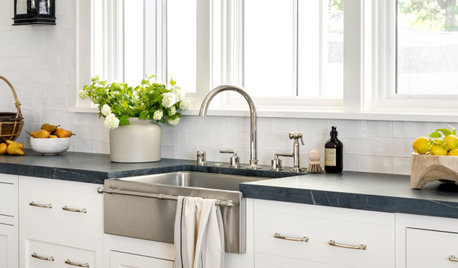

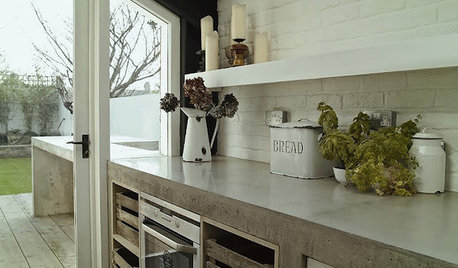
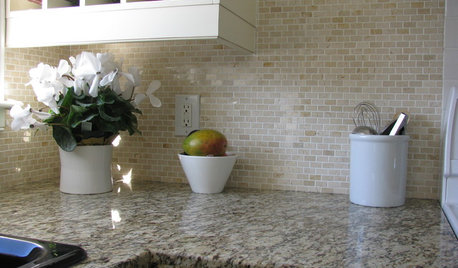

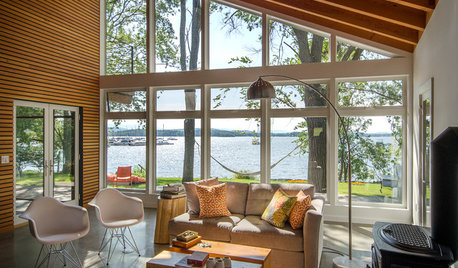

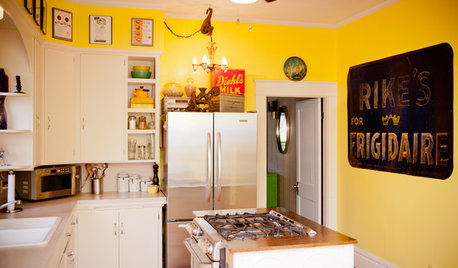
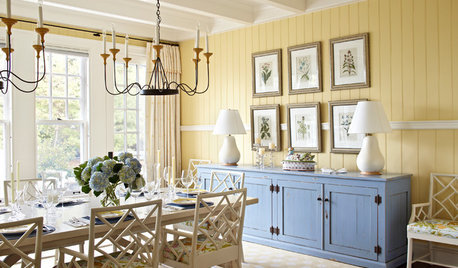
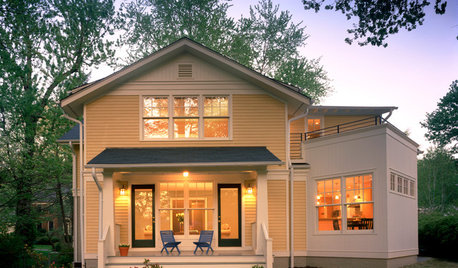







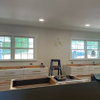
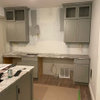
Fori